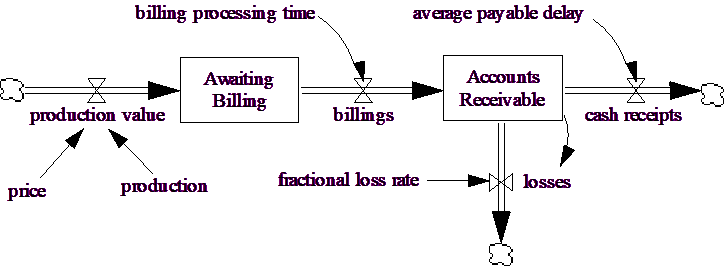One of the important formulation techniques that will be used in this model is the initialization of the levels to an equilibrium or steady state value. In equilibrium, the total inflows and outflows of each stock must be equal. To understand how this is accomplished consider what would happen in a structure such as that used above if price and production were both constant over a long period of time. As long as the product of production value is bigger than billings, Awaiting Billing will rise (or fall if smaller). But as Awaiting Billing rises, so will billings. Over time billings will rise until it is equal to production value and then Awaiting Billing will stop changing. With constant inputs, the above structure yields constant output for both billings and, by the same argument, cash receipts.
To work this backward we require that the outflow (billing) and the inflow (production value) to Awaiting Billing be equal:
billings = production value
substituting this into the equation for billinggives:
Awaiting Billing/billing processing time = production value
or
Awaiting Billing = production value * billing processing time
We can use this expression to initialize Awaiting Billing. Using the same logic we can initialize
Accounts Receivable = billings * average payable delay
When Vensim tries to compute an initial value for Accounts Receivable it will need to compute billings, and therefore Awaiting Billing and therefore production value and therefore price and production. Vensim automatically takes care of this computational sequence problem and will inform you if it discovers any anomalies.
With the above formulation accounts receivable only decreases when money is received. It is, unfortunately, also true that some people do not pay their bills and these need to be written off. We can add an outflow of losses to handle this problem:

where
losses = Accounts Receivable * fractional loss rate
The addition of losses complicates the selection of an initial value for Accounts Receivable somewhat. Now we need billings to be equal to cash receipts + losses. Substituting the different formulae we have:
| Accounts Receivable = billings / |
| (1/average payable delay + fractional loss rate) |
Here fractional loss rate is equivalent to the reciprocal of a time constant.
It is not necessary to initialize structure in equilibrium, but it can be very helpful. It is very common for the early part of a simulation run to be dominated by adjustments from imbalances in Levels and Rates. The dynamics generated by this imbalance do not tend to have intrinsic importance and can severely hamper the understanding of model dynamics. For this particular model, we will actually be starting with production at 0, so we could have simply set the two levels to 0 as well. However, the structure we are developing is designed to be easily used in other models and has been made more general with this in mind.